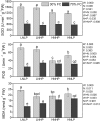Alleviation of drought stress in Phyllostachys edulis by N and P application
- PMID: 29321617
- PMCID: PMC5762838
- DOI: 10.1038/s41598-017-18609-y
Alleviation of drought stress in Phyllostachys edulis by N and P application
Abstract
The aim of this study was to explore whether nutrition supply can improve the drought tolerance of Moso bamboo under dry conditions. One-year-old seedlings were exposed to two soil water content levels [wellwatered, 70 ± 5% soil-relative-water-content (SRWC) and drought stress, 30 ± 5% SRWC] and four combinations of nitrogen (N) and phosphorus (P) supply (low-N, low-P, LNLP; low-N, high-P, LNHP; high-N, high-P, HNHP; and high-N, low-P, HNLP) for four months. Plant growth, photosynthesis, chlorophyll fluorescence, water use efficiency and cell membrane stability were determined. The results showed that drought stress significantly decreased total biomass, net-photosynthesis (Pn), stomatal-conductance (gs), leaf-chlorophyll-content (Chlleaf), PSII-quantum-yield (ΦPSII), maximum-quantum-yield-of-photosynthesis (Fv/Fm), photochemical-quenching-coefficient (qP), leaf-instantaneous-water-use efficiency (WUEi), relative-water-content (RWC), photosynthetic-N-use-efficiency (PNUE), and photosynthetic-P-use-efficiency (PPUE). N and P application was found to be effective in enhancing the concentration of leaf N, gs, and Pn while reducing the production of reactive oxygen species under both water regimes. Under LNHP, HNHP and HNLP treatments, the decreases in total biomass, Pn, Chlleaf and Fv/Fm of drought-stressed were less evident than the decreases under LNLP. The study suggests that nutrient application has the potential to mitigate the drastic effects of water stress on Moso bamboo by improving photosynthetic rate, water-use efficiency, and increasing of membrane integrity.
Conflict of interest statement
The authors declare that they have no competing interests.
Figures


Similar articles
-
[Effects of soil progressive drought during the flowering and boll-forming stage on gas exchange parameters and chlorophyll fluorescence characteristics of the subtending leaf to cotton boll].Ying Yong Sheng Tai Xue Bao. 2014 Dec;25(12):3533-9. Ying Yong Sheng Tai Xue Bao. 2014. PMID: 25876405 Chinese.
-
Effects of soil water and nitrogen availability on photosynthesis and water use efficiency of Robinia pseudoacacia seedlings.J Environ Sci (China). 2013 Mar 1;25(3):585-95. doi: 10.1016/s1001-0742(12)60081-3. J Environ Sci (China). 2013. PMID: 23923433
-
Regulation of ROS through proficient modulations of antioxidative defense system maintains the structural and functional integrity of photosynthetic apparatus and confers drought tolerance in the facultative halophyte Salvadora persica L.J Photochem Photobiol B. 2018 Dec;189:214-233. doi: 10.1016/j.jphotobiol.2018.10.021. Epub 2018 Oct 31. J Photochem Photobiol B. 2018. PMID: 30396132
-
Drought stress-induced physiological mechanisms, signaling pathways and molecular response of chloroplasts in common vegetable crops.Crit Rev Biotechnol. 2021 Aug;41(5):669-691. doi: 10.1080/07388551.2021.1874280. Epub 2021 Feb 1. Crit Rev Biotechnol. 2021. PMID: 33525946 Review.
-
Exploring environmental selection on genome size in angiosperms.Trends Plant Sci. 2021 Oct;26(10):1039-1049. doi: 10.1016/j.tplants.2021.06.001. Epub 2021 Jul 1. Trends Plant Sci. 2021. PMID: 34219022 Review.
Cited by
-
Growing in Mixed Stands Increased Leaf Photosynthesis and Physiological Stress Resistance in Moso Bamboo and Mature Chinese Fir Plantations.Front Plant Sci. 2021 May 20;12:649204. doi: 10.3389/fpls.2021.649204. eCollection 2021. Front Plant Sci. 2021. PMID: 34093612 Free PMC article.
-
Fertilization and seasonality influence on the photochemical performance of tree legumes in forest plantation for area recovery in the Amazon.PLoS One. 2021 May 21;16(5):e0243118. doi: 10.1371/journal.pone.0243118. eCollection 2021. PLoS One. 2021. PMID: 34019538 Free PMC article.
-
Drought stress introduces growth, physiological traits and ecological stoichiometry changes in two contrasting Cunninghamia lanceolata cultivars planted in continuous-plantation soils.BMC Plant Biol. 2021 Aug 18;21(1):379. doi: 10.1186/s12870-021-03159-3. BMC Plant Biol. 2021. PMID: 34407754 Free PMC article.
-
Response of native (Quercus robur L.) and alien (Quercus rubra L.) species to water stress and nutrient input in European temperate ecosystems.Physiol Plant. 2025 Jan-Feb;177(1):e70070. doi: 10.1111/ppl.70070. Physiol Plant. 2025. PMID: 39831352 Free PMC article.
-
Selenium Regulates Antioxidant, Photosynthesis, and Cell Permeability in Plants under Various Abiotic Stresses: A Review.Plants (Basel). 2022 Dec 22;12(1):44. doi: 10.3390/plants12010044. Plants (Basel). 2022. PMID: 36616173 Free PMC article. Review.
References
-
- Abedi T, Pakniyat H. Antioxidant enzyme changes in response to drought stress in ten cultivars of oilseed rape (Brassica napus L.) Czech J. Genet Plant. 2010;46:27–34.
-
- Nawaz F, Ahmad R, Waraich EA, Naeem MS, Shabbir RN. Nutrient uptake, physiological responses, and yield attributes of wheat (Triticum aestivum L.) exposed to early and late drought stress. J. Plant Nutr. 2012;35:961–974. doi: 10.1080/01904167.2012.663637. - DOI
-
- Li C, Wang K. Differences in drought responses of three contrasting Eucalyptus microtheca F. Muell. Populations. Forest ecology and management. 2003;179:377–385. doi: 10.1016/S0378-1127(02)00552-2. - DOI
-
- Yin CY, Berninger F, Li CY. Photosynthetic responses of Populus przewalski subjected to drought stress. Photosynthetica. 2006;44:62–68. doi: 10.1007/s11099-005-0159-y. - DOI
-
- Lei Y, Yin C, Li C. Differences in some morphological, physiological, and biochemical responses to drought stress in two contrasting populations of Populus przewalskii. Physiol Planta. 2006;127:182–191. doi: 10.1111/j.1399-3054.2006.00638.x. - DOI
Publication types
MeSH terms
Substances
LinkOut - more resources
Full Text Sources
Other Literature Sources

